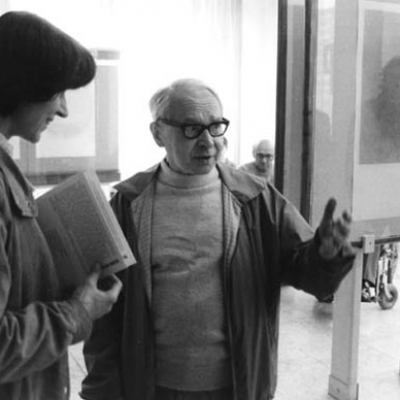
Václav Boštík
Václav Boštík se narodil v roce 1913 v Horním Újezdu u Litomyšle. Studoval Výtvarnou akademii v Praze v ateliéru Willyho Nowaka. Od roku 1942 byl členem skupiny Umělecká beseda - její činnost byla formálně ukončena v roce 1972 a po roce 1989 znovu obnovena. V roce 1960 s Václavem Bartovským inicioval založení skupiny UB 12, která výrazně poznamenala vývoj českého umění v 60. letech (mezi členy byli například Adriena Šimotová, Stanislav Kolíbal, Vladimír a Věra Janouškovi, Jiří John a další). Boštík již ve druhé půlce 50. let, kdy oficiální výtvarné scéně vládl nadiktovaný socialistický realismus, přešel ke zcela abstraktní tvorbě, v níž řeší základní otázky bytí prostřednictvím jednoduchých geometrických tvarů a hry světla dané kombinací barev. Jeho plátna jako by vytvářela silová duchovní pole a vyzařovala energii kosmu. Každý, kdo se s nimi setkal, potvrdí jejich magičnost a neuvěřitelnou sílu. Boštíkova tvorba je zastoupena ve stálých sbírkách mnoha galerií. V období komunistické represe však vystavoval pouze neoficiálně; v jedné době se živil i restaurováním sgrafit v zámku Litomyšl. V 60. letech se konala ještě jeho samostatná výstava v Nové síni a těsně před rokem 1970 se stačil podílet v galerijní radě na programu Špálovy galerie pod vedením teoretika Jindřicha Chalupeckého. V době normalizace se účastnil pouze neoficiálních výstav. Boštíkova oficiální samostatná výstava se konala na jaře roku 1989 v Galerii hlavního města Prahy na Staroměstské radnici. Jednota jeho života a práce, ovlivněná náboženskou vírou, byla zcela jasná. Zpočátku realistická malba se již na konci 30. let formovala v abstraktní. Plocha obrazu pro autora představovala silové pole. Na jedné straně vznikaly lineární symetrické obrazy a na druhé shluky barevných polí. Tyto polohy souvisely s Boštíkovou jedinečnou reflexí přírodních a vesmírných souvislostí. Svou tvorbou vedl svůj rozhovor s věčností. Zemřel v roce 2005 a jeho tvorba je na uměleckém trhu velmi vyhledávaná a ceněná. |
Václav Boštík was born in 1913 in Horní Újezd, close to the city of Litomyšl. He graduated from the Academy of Fine Arts in Prague, where he studied in the studio of Willy Nowak. He was a member of the art group Umělecká beseda from 1942 whose activity was formally halted in 1972 and was revived after 1989. In 1960 Boštík, along with Václav Bartovský, initiated the establishment of the art group UB 12 which significantly influenced the development of Czech art during the 1960s (other members were, for example, Adriena Šimotová, Stanislav Kolíbal, Vladimír and Věra Janoušeks and Jiří John). As early as in the second half of the 1950s – when the official artistic scene was dominated by the forcefully imposed Social Realism – Boštík switched to total abstract work in which he solved the essential issues of existence through simple geometric shapes and play of light, given by color combinations. His canvases as if produced powerful spiritual fields and emanated cosmic energy. Everybody who has ever encountered them speaks about their magic and incredible power. Boštík’s works are part of permanent collections of many galleries. In the period of the Communist repression he, however, exhibited on solely an unofficial basis and there even was a period when he lived on restoring sgraffiti at the Litomyšl chateau. Still during the 1960s, his solo exhibition was held in the New Hall [Nová síň] gallery and shortly before 1970 he also managed to participate in the gallery board and co-develop the exhibition program of the Špála gallery under the leadership of the leading Czech art theoretician, Jindřich Chalupecký. He was part of exclusively unofficial exhibitions during the period of the so-called Czechoslovak normalization. Boštík’s official solo exhibition was organized by the Prague Municipal Gallery at the Old Town Hall in the spring of 1989. The integrity of Boštík’s work and life, influenced by his religious faith, was plain. He switched from the initial realistic painting to Abstraction as early as at the end of the 1930s. The painting surface represented a field force to him. On one hand, he created linear symmetrical paintings and clusters of color fields on the other hand. These positions were linked with Boštík’s unique reflection of natural and universal contexts. He talked with the eternity through his works. Boštík died in 2005 and his works are highly sought-after and highly appreciated on the art market both in the Czech Republic and abroad. |